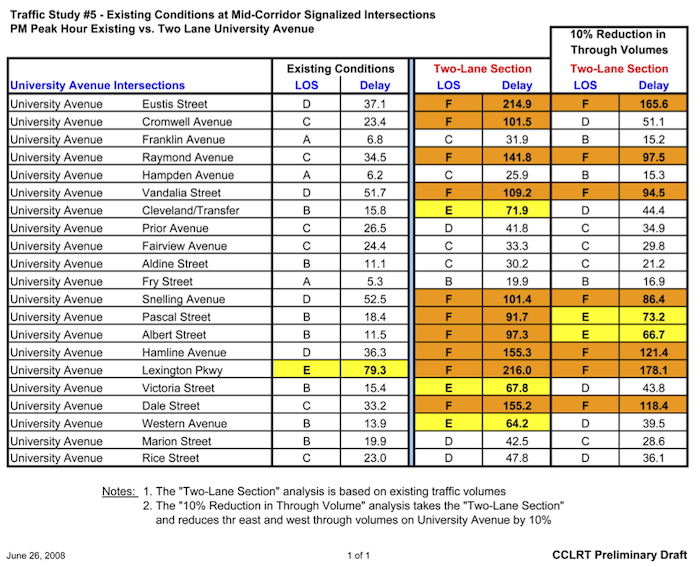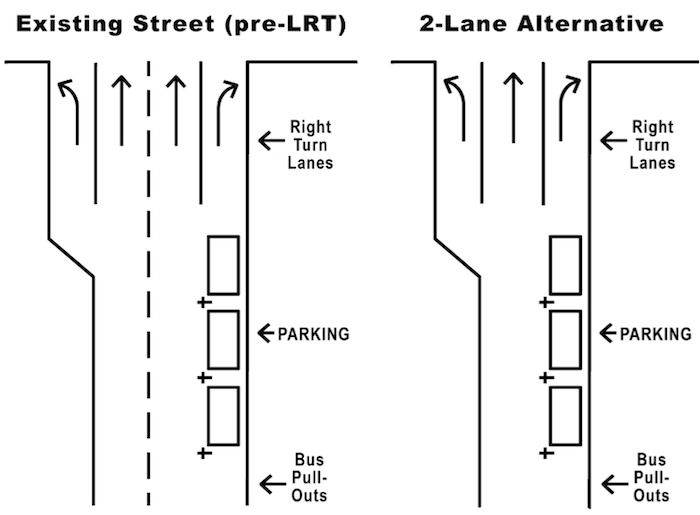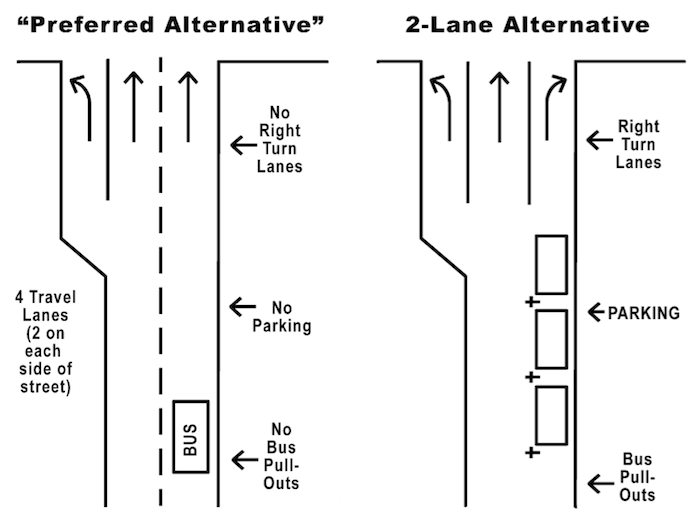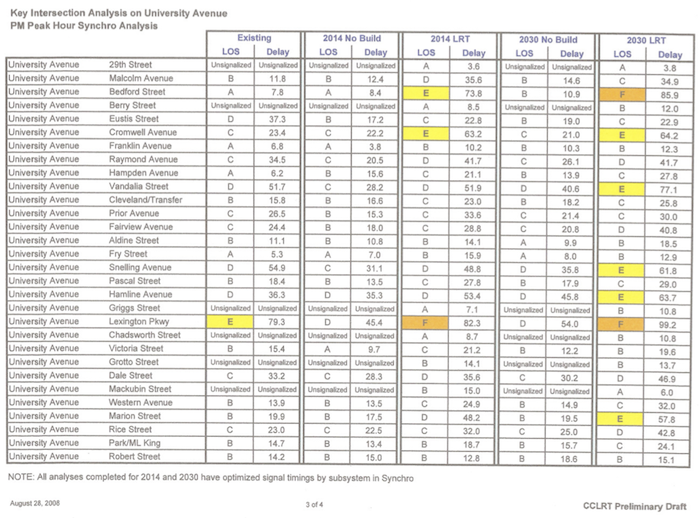University Avenue
Mission
Enhancing bicyclist safety along University Avenue is another SPBC priority. (2010)
Our request of the FTA and MET Council
The Saint Paul Bicycle Coalition requests that the Federal Transportation Administration (FTA) and the Metropolitan Council reexamine the current street programming plan for University Avenue post-light rail transit construction. The current plan calls for two vehicle travel lanes in each direction (four total travel lanes). A review would examine the benefits of having a single vehicle travel lane in each direction, a parking lane with bus pull-outs and right turn lanes, and a bike lane. The Avenue's planned minimum width of 25'would permit an 11' travel lane, 8' parking lane and 6' bike or buffer lane, creating a "Complete Street" to accommodate all modes of transportation. We request that the FTA and MET Council restudy and commit to at least try this programming configuration when the LRT project is completed. We are not suggesting any physical street design changes but only changes in how the avenue is striped and programmed.
Problems with the current "4-Lane" street programming plans
🚲 Current programming plans for University Avenue would eliminate on-street parking in order to maintain two vehicle travel lanes in each direction. This would be bad for small businesses, especially take-out and other businesses that rely on vehicle pick-ups and drop-offs.
🚲 Without on-street parking, small businesses may lose customers and revenue, forcing them to reduce staff, relocate or even go out of business. Because many of these businesses are minority and immigrant-owned, the negative economic impacts of job losses would disproportionately impact minority and immigrant communities along the corridor. This in turn would destabilize adjacent neighborhoods where many of these business owners and employees make their homes.
🚲 Eliminating parking would remove both physical and psychological protection for pedestrians. With traffic driving right next to the curb, there would be no buffer to prevent vehicles from splattering rain or slush on what will often be narrower sidewalks and no barrier from out-of-control vehicles. The proposed extra traffic lane will also make it harder for pedestrians to safely cross the avenue at numerous unsignalized crosswalks.
🚲 Eliminating parking would also limit access for the disabled. There are approximately 350,000 valid disability parking certificates/plates in circulation in the state of Minnesota. The primary eligibility criterion for a disability parking certificate/plate is an inability to walk 200 feet without resting or without the aid of a mobility device. Since retail building access is provided at the front of the building for most of the businesses facing University Avenue, it is critically important that on-street parking be provided so that consumers with disabilities can access and support local businesses.
🚲 Maintaining a second vehicle travel lane will force bicycles off of University Avenue. A substantial number of cyclists currently use the avenue for both local trips and longer commute trips through the corridor because University Avenue is the only east-west through street for bicyclists that crosses the various railroad, warehouse, and highway obstacles. The Central Corridor Bike-Walk Action Plan proposes moving cyclists two blocks north to Charles Avenue. However, Charles Avenue stops at Park Street on the east end of the corridor and does not go past N. Aldine Street on the west end of the corridor. It also lacks traffic lights at major intersections like Snelling, Lexington and Rice that would enable bicycle commuters to cross these streets during rush hour.
🚲 With the current plan for two vehicle travel lanes in each direction, the flow of traffic in the curbside lane will be impeded by the #16 bus stopping every two blocks and right-turning vehicles waiting for pedestrians at intersections. By contrast, maintaining a parking lane would enable parts of the curbside lane to be used for bus pull-outs and right turn lanes.
🚲 The local traffic studies to date have been entirely auto-centric, focused on the delay that motorists might experience if vehicle capacity is reduced. Maintaining four lanes of through traffic at the expense of on-street parking and bicycle lanes will diminish conditions for pedestrians and cyclists at a time when the city is promoting these sustainable modes and trying to reduce dependency on automobiles. Motor vehicle congestion mitigation should not drive transportation planning. At a certain level, vehicle congestion can be beneficial. Congested locations are desirable to many businesses with walk-in customers, and lower speeds reduce the risk of injury and death in the event of a collision. Congestion can also hasten the transition from automobile dependency to transit, walking, biking and improved land use. Partly for these reasons, expanding motor vehicle capacity at the same time as expanding transit capacity negates the advantages of transit investment.
🚲 In large part, the purpose of this LRT project is to revitalize University Avenue businesses and neighborhoods and turn them into vibrant destinations. Yet maintaining 4 vehicle travel lanes and eliminating parking reduces the avenue to a travel corridor "chute" where people cannot stop but merely pass through on their way to one or the other downtown. By making conditions worse for pedestrians, bicycles and businesses, the Twin Cities would be missing a golden opportunity to create a vibrant "Complete Street" that is accessible and beneficial to all users.
Benefits of a "2-Lane Alternative"
We advocate "right-sizing" University Avenue to one travel lane in each direction, restoring a substantial amount of on-street parking and using sections of the parking lanes for right-turn lanes (at intersections) and for bus pull-outs. This is simply an issue of "striping" or "programming" the street as the existing 25 foot wide minimum space will allow for 11 foot travel lane, 8 foot parking lane and 6 foot buffer or bike lane. We believe this programming alternative has a number of advantages:
🚲 It enables many small businesses to maintain their on-street parking. If well managed (through metering or short time limits), even a few spaces can successfully serve many businesses. This will help many businesses avoid failure or relocation.
🚲 Restored parking and bus pull-outs will make commercial pickups and deliveries to these businesses much easier.
🚲 A parking lane allows lift-vans and people with impaired mobility better access to small businesses, many of whom only have ADA accessible entrances in front of their stores.
🚲 By restoring some on-street parking, the 2-Lane Alternative reduces the amount of traffic that will be cutting into and driving around local neighborhoods looking for parking—a major concern of local neighborhood residents.
🚲 Parked cars will serve to physically and psychologically protect the sidewalks and pedestrians from splatter and errant, high-speed vehicles, making the sidewalks safer and more pleasant to use.
🚲 Reducing University Avenue to one travel lane in each direction will narrow the distance that pedestrians have to cross at numerous unsignalized mid-block crosswalks that serve the back ends of station platforms or at LRT and street crossing points. This will make it easier and safer for pedestrians to get across the street and will reduce accidents, injuries and fatalities.
🚲 A 2-Lane Alternative allows bicyclists continued access to University. If a bike lane is provided, it will also reduce sidewalk riding (a problem on parts of the current street).
🚲 By providing right turn lanes, bus pull-outs, and legal stopping places for deliveries, a 2-Lane Alternative may actually provide better automobile Level of Service (LOS). Vehicles in the 4-lane configuration will constantly be stopping in the outside lane for buses and right turning vehicles awaiting pedestrians. This will tie up traffic and cause frequent lane changes as other vehicles try to avoid these stops. All these starts, stops, and lane changes reduce the Level of Service for cars. Also, reducing the road to one travel lane in each direction will reduce the number of vehicles reaching intersections at any given time and can improve the LOS for those intersections. Many studies and literature on "4-3 conversions" or "Road diets" support these assertions.
Flaws in the Met Council's 2-Lane Study and in the Project's current Environmental Impact Statement (E.I.S.)
In 2008, at the request of city officials and community groups, the MET Council did a very abbreviated study of what impact a 2-Lane Alternative would have on intersection Levels of Service (LOS) at current traffic volumes and at an arbitrary 10% reduced traffic volume—assuming that LRT would cause some reduction in vehicular traffic. The study only used a traffic-modeling program called SYNCRO with existing signal timings. There was no modeling of actual pedestrian counts, buses stopping or other factors that could impact LOS. The "PM Peak Hour" table from that study is depicted on the next page.

The study showed that (with a 10% traffic reduction) there would be nine failed intersections as compared to the current one failed intersection and thus concluded that a 2-Lane Alternative was not feasible.
The most glaring problem with the study is it compared the wrong things. It compared the existing intersection configuration to the 2-Lane Alternative. See illustration on next page:

In reality, it should have compared what is called the 4-Lane "Preferred Alternative" in the project's E.I.S. to the 2-Lane Alternative …as both of these only have three lanes at each intersection (as opposed to four in the existing configuration). See Illustration Below:

The "Preferred Alternative's" lack of right turn lanes and bus pullouts greatly reduces its Level of Service. Thus, the 2-Lane Alternative should have been compared to a simple SYNCRO Intersection Level of Service study of the 4-Lane Preferred Alternative. Such a study can be found in the Draft E.I.S. for the Central Corridor LRT project. Its "PM Peak Hour" table is depicted below.

You will see that the "Preferred Alternative" has anywhere from three to seven failed intersections (depending on the time frame) …as compared to nine failed intersections for the 2-Lane Alternative. It is important to note that this SYNCRO modeling of the Preferred Alternative did not include the impact of buses stopping in the outside travel lane or actual pedestrian movements in intersections, which will be quite substantial at LRT stations and greatly impact vehicle Level of Service. If these additional factors were modeled, the Preferred Alternative might well have the exact same number of failed intersections (9) as the 2-Lane Alternative. The final E.I.S. used additional modeling software to make two of these seven failed intersections "disappear," using "optimized signal timings." However, On pg 30, Chapter 6 of the E.I.S., it says that optimized timing "would probably not significantly alter LOS." Thus, the real comparison, even using the MET Council's own data, is between 3-7 failed intersections for the Preferred Alterative versus nine failed intersections for the 2-Lane Alternative.
Also, the 2-Lane Alternative study only assumed a 10% reduction in traffic due to LRT. Portland and other cities have seen as much as 30% reductions, which would substantially change both studies' results. Rising Gas prices will also reduce Vehicle Miles Traveled (VMT) and could similarly change the results of both studies, reducing the number of failed intersections.
Regardless, Even at a difference of 3-7 failed intersections versus 9 failed intersections, it is absolutely insane public policy to sacrifice the well being of an entire corridor's worth of small businesses, pedestrians, cyclists and the disabled just to eliminate a few failed intersections.
Conclusion
Contrary to how it is being depicted by some 4-Lane advocates, we have a choice between two bad alternatives for motor vehicle Level of Service. The 2-Lane Alternative is clearly the better choice. The current E.I.S. fails to seriously consider the needs of pedestrians, cyclists and small businesses. A 2-Lane Alternative would take these important non-automotive needs into consideration. It should be more seriously studied and tried.
We urge that it be tried when the project opens because people will be used to a reduced two-lane boulevard during construction and it is harder to take away space from cars after the fact than to try it out initially. If this two-lane (with on-street parking) "trial" doesn't work, it is easy to revert the street programming to the 4-Lane Preferred Alternative.
Despite high traffic volumes on parts of University, we believe a 2-Lane Alternative will succeed because some portion of "Peak" traffic thru the corridor will go to the I-94 freeway two blocks away and some will disappear altogether as people combine discretionary trips or take public transit. No "origin-destination" studies were ever done for traffic on University but it is classified by MnDOT as a "reliever" for I-94 and there is substantial evidence that some peak hour traffic consists of vehicles attempting to escape congestion on the nearby freeway.
Some engineers argue that traffic will cut thru adjacent neighborhoods when faced with congestion, but there is no evidence for this and it hasn't occurred during past periods of increased congestion, such as the I-35 bridge collapse. In fact there is no other street besides University that crosses all the way from east to west, thru the corridor and few other streets that have the traffic lights necessary to cross major north/south boulevards. Thus, a motorist's only choice is University or the freeway and we think many will choose the freeway. The bigger danger to adjacent neighborhoods is increased traffic looking for parking on streets and alleys, if we choose a 4-Lane University and eliminate its on-street parking.
With a 2-Lane Alternative, Big Box stores worried about reductions in their traffic volumes will still be able to get ample traffic flow from Snelling, Hamline and Lexington avenues—all major 4-lane boulevards with connections to I-94 and Saint Anthony Avenue, which runs behind most of their malls.
Other cities have successfully done 4-3 conversions on major boulevards that had similar commercial configurations and levels of vehicle traffic as University Avenue, and a few of these conversions were done as part of LRT projects, such as Interstate Avenue in Portland, Oregon.
We urge the MET Council and FTA to study these and remodel a comparison of the Preferred Alternative and 2-Lane Alternative, taking into account bus stops, right turns, pedestrian movements (both at mid-block and intersections), small businesses' need for on-street parking and Bicyclists' need for access to University. We urge the FTA and MET Council to allow us to initially try a 2-Lane Alternative programming configuration.
It's only "programming"-- stripes on the pavement-- but it could have a huge impact on the success and failure of this project and on the success and failure of the neighborhoods through which it passes.
Sincerely,
Andy Singer, Co-Chair
Dana DeMaster, Co-Chair
Saint Paul Bicycle Coalition
(651) 917-3417
andy@andysinger.com
saintpaulbike@gmail.com
We can supply PDFs of all the documents referred to in this letter. Please contact us if you have any questions.
